北师大版(2019)选择性必修第三册Unit 9 Human Biology Lesson 3 Epidemics Explained 课件-(18张ppt)
文档属性
| 名称 | 北师大版(2019)选择性必修第三册Unit 9 Human Biology Lesson 3 Epidemics Explained 课件-(18张ppt) | 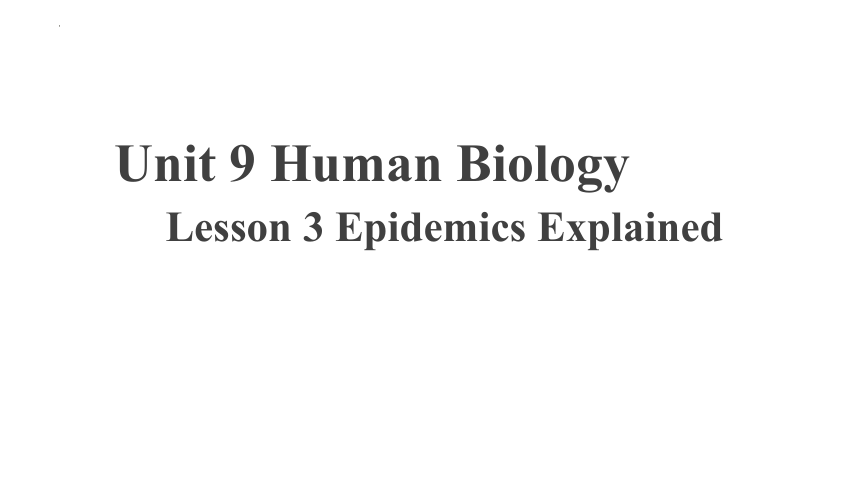 | |
| 格式 | zip | ||
| 文件大小 | 1.6MB | ||
| 资源类型 | 教案 | ||
| 版本资源 | 北师大版(2019) | ||
| 科目 | 英语 | ||
| 更新时间 | 2022-12-26 18:42:31 | ||
图片预览


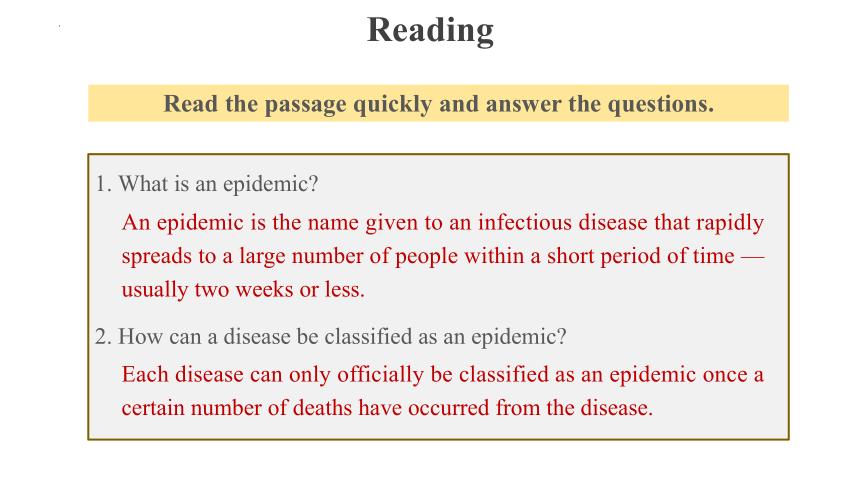
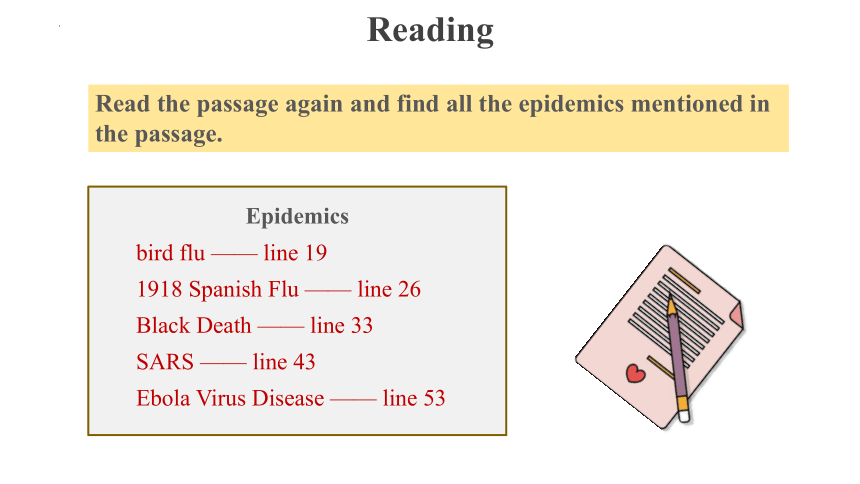
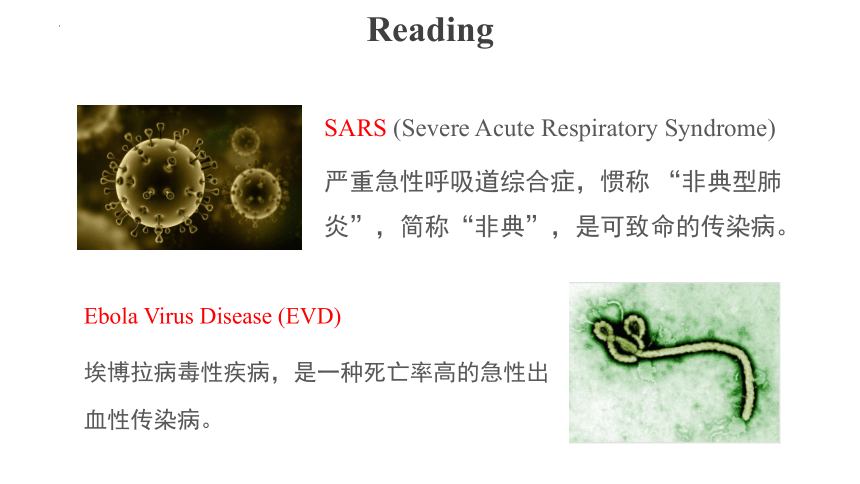
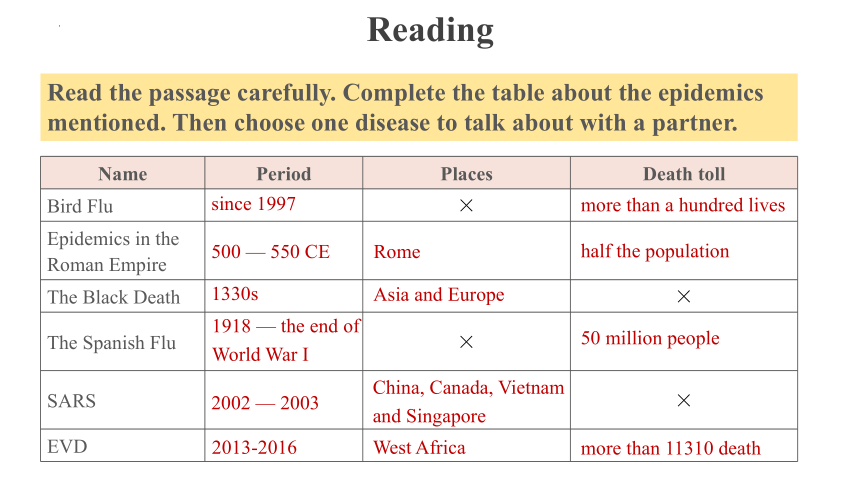
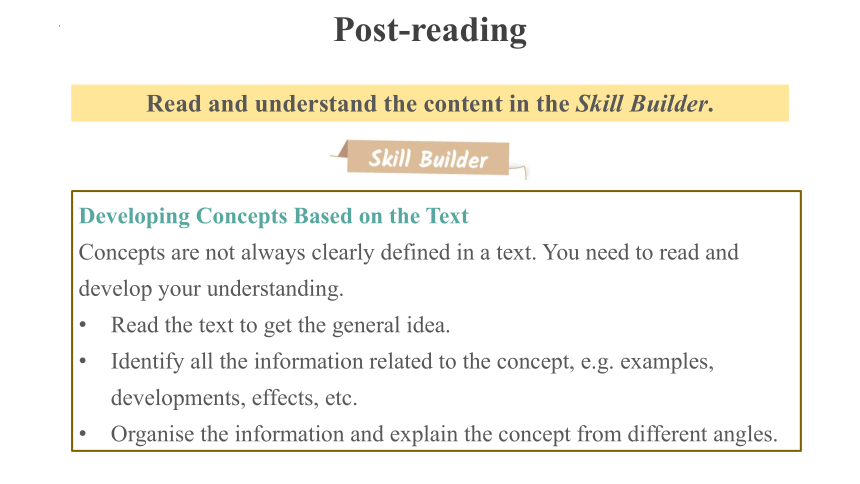
文档简介
(共18张PPT)
Unit 9 Human Biology
Lesson 3 Epidemics Explained
Warming-up
□ An epidemic is the rapid spread of an infectious disease.
□ An epidemic can affect a large number of people in a given population.
□ An epidemic can occur within a short period of time, usually two weeks
or less.
□ An epidemic may spread to several countries or continents.
□ Some common viruses, such as the common cold, are not epidemics.
□ A new epidemic can be a different variation of a virus that people caught
in the past.
What do you know about epidemics Tick the statements that you think are correct.
√
√
√
√
√
√
Reading
Read the passage quickly and answer the questions.
1. What is an epidemic
2. How can a disease be classified as an epidemic
An epidemic is the name given to an infectious disease that rapidly spreads to a large number of people within a short period of time — usually two weeks or less.
Each disease can only officially be classified as an epidemic once a certain number of deaths have occurred from the disease.
Reading
Read the passage again and find all the epidemics mentioned in the passage.
Epidemics
bird flu —— line 19
1918 Spanish Flu —— line 26
Black Death —— line 33
SARS —— line 43
Ebola Virus Disease —— line 53
Reading
SARS (Severe Acute Respiratory Syndrome)
严重急性呼吸道综合症,惯称 “非典型肺炎”,简称“非典”,是可致命的传染病。
Ebola Virus Disease (EVD)
埃博拉病毒性疾病,是一种死亡率高的急性出血性传染病。
Reading
Name Period Places Death toll
Bird Flu ×
Epidemics in the Roman Empire
The Black Death ×
The Spanish Flu ×
SARS ×
EVD
Read the passage carefully. Complete the table about the epidemics mentioned. Then choose one disease to talk about with a partner.
since 1997
more than a hundred lives
500 — 550 CE
Rome
half the population
1330s
Asia and Europe
1918 — the end of World War I
50 million people
2002 — 2003
China, Canada, Vietnam and Singapore
2013-2016
West Africa
more than 11310 death
Developing Concepts Based on the Text
Concepts are not always clearly defined in a text. You need to read and develop your understanding.
Read the text to get the general idea.
Identify all the information related to the concept, e.g. examples, developments, effects, etc.
Organise the information and explain the concept from different angles.
Post-reading
Read and understand the content in the Skill Builder.
Post-reading
□ when epidemics started
□ examples of epidemics
□ treatments
□ baseline number of deaths of epidemics
□ definition
□ when it ended
□ possible causes of epidemics
□ possible solutions
Tick the aspects of information that are mentioned in the passage.
√
√
√
√
√
Post-reading
Use a diagram to demonstrate in a logical way how the aspects of information are organised.
Epidemics
Post-reading
What are the main features of an epidemic Give at least two examples to illustrate your points.
What should different countries do to prevent outbreak of epidemics in the future Why
What does the title mean to you What does the writer want to convey in the passage
Who do you think the passage is written for
Work in groups and discuss the questions.
Post-reading
What are the main features of an epidemic Give at least two examples to illustrate your points.
Post-reading
They should work together because teamwork among nations across the globe can save lives. This is a good example of building a community with shared future for mankind.
2 What should different countries do to prevent outbreak of
epidemics in the future Why
Post-reading
◆ The title means that the passage will explain questions about
epidemics.
3 What does the title mean to you What does the writer want to
convey in the passage
◆ The author wants to convey the information that we are always
on our way to find an explanation to epidemics so as to find
cure. It also implies that epidemics occurred naturally and
inevitably(不可避免地). We can only explain it, and cannot
prevent it or stop it completely now.
Post-reading
Who do you think the passage is written for
This is a popular science article. It is more likely to be written for people who is interested in this topic or who has a lot of questions or misunderstanding of epidemics.
Post-reading
Epidemics can be caused by …
Diseases can only be officially classified as epidemics when …
The Spanish Flu spread worldwide because …
Since the end of the SARS epidemic, scientists …
Countries need to work together to conduct thorough and systematic research because …
Complete these sentences in your own words.
Post-reading
Epidemics can be caused by a virus being carried into an area, or changes in the way people live.
Diseases can only be officially classified as epidemics when a baseline number of people have died from the disease.
The Spanish Flu spread worldwide because soldiers and other people were moving and travelling around the world after World War I.
Since the end of the SARS epidemic, scientists have been doing experiments on treatments to prevent further outbreaks.
Countries need to work together to conduct thorough and systematic research because teamwork among nations across the globe can save lives.
Assignment
Search online in groups and find some information about epidemics in China or Asia. Report your information to the class.
Goodbye!
Unit 9 Human Biology
Lesson 3 Epidemics Explained
Warming-up
□ An epidemic is the rapid spread of an infectious disease.
□ An epidemic can affect a large number of people in a given population.
□ An epidemic can occur within a short period of time, usually two weeks
or less.
□ An epidemic may spread to several countries or continents.
□ Some common viruses, such as the common cold, are not epidemics.
□ A new epidemic can be a different variation of a virus that people caught
in the past.
What do you know about epidemics Tick the statements that you think are correct.
√
√
√
√
√
√
Reading
Read the passage quickly and answer the questions.
1. What is an epidemic
2. How can a disease be classified as an epidemic
An epidemic is the name given to an infectious disease that rapidly spreads to a large number of people within a short period of time — usually two weeks or less.
Each disease can only officially be classified as an epidemic once a certain number of deaths have occurred from the disease.
Reading
Read the passage again and find all the epidemics mentioned in the passage.
Epidemics
bird flu —— line 19
1918 Spanish Flu —— line 26
Black Death —— line 33
SARS —— line 43
Ebola Virus Disease —— line 53
Reading
SARS (Severe Acute Respiratory Syndrome)
严重急性呼吸道综合症,惯称 “非典型肺炎”,简称“非典”,是可致命的传染病。
Ebola Virus Disease (EVD)
埃博拉病毒性疾病,是一种死亡率高的急性出血性传染病。
Reading
Name Period Places Death toll
Bird Flu ×
Epidemics in the Roman Empire
The Black Death ×
The Spanish Flu ×
SARS ×
EVD
Read the passage carefully. Complete the table about the epidemics mentioned. Then choose one disease to talk about with a partner.
since 1997
more than a hundred lives
500 — 550 CE
Rome
half the population
1330s
Asia and Europe
1918 — the end of World War I
50 million people
2002 — 2003
China, Canada, Vietnam and Singapore
2013-2016
West Africa
more than 11310 death
Developing Concepts Based on the Text
Concepts are not always clearly defined in a text. You need to read and develop your understanding.
Read the text to get the general idea.
Identify all the information related to the concept, e.g. examples, developments, effects, etc.
Organise the information and explain the concept from different angles.
Post-reading
Read and understand the content in the Skill Builder.
Post-reading
□ when epidemics started
□ examples of epidemics
□ treatments
□ baseline number of deaths of epidemics
□ definition
□ when it ended
□ possible causes of epidemics
□ possible solutions
Tick the aspects of information that are mentioned in the passage.
√
√
√
√
√
Post-reading
Use a diagram to demonstrate in a logical way how the aspects of information are organised.
Epidemics
Post-reading
What are the main features of an epidemic Give at least two examples to illustrate your points.
What should different countries do to prevent outbreak of epidemics in the future Why
What does the title mean to you What does the writer want to convey in the passage
Who do you think the passage is written for
Work in groups and discuss the questions.
Post-reading
What are the main features of an epidemic Give at least two examples to illustrate your points.
Post-reading
They should work together because teamwork among nations across the globe can save lives. This is a good example of building a community with shared future for mankind.
2 What should different countries do to prevent outbreak of
epidemics in the future Why
Post-reading
◆ The title means that the passage will explain questions about
epidemics.
3 What does the title mean to you What does the writer want to
convey in the passage
◆ The author wants to convey the information that we are always
on our way to find an explanation to epidemics so as to find
cure. It also implies that epidemics occurred naturally and
inevitably(不可避免地). We can only explain it, and cannot
prevent it or stop it completely now.
Post-reading
Who do you think the passage is written for
This is a popular science article. It is more likely to be written for people who is interested in this topic or who has a lot of questions or misunderstanding of epidemics.
Post-reading
Epidemics can be caused by …
Diseases can only be officially classified as epidemics when …
The Spanish Flu spread worldwide because …
Since the end of the SARS epidemic, scientists …
Countries need to work together to conduct thorough and systematic research because …
Complete these sentences in your own words.
Post-reading
Epidemics can be caused by a virus being carried into an area, or changes in the way people live.
Diseases can only be officially classified as epidemics when a baseline number of people have died from the disease.
The Spanish Flu spread worldwide because soldiers and other people were moving and travelling around the world after World War I.
Since the end of the SARS epidemic, scientists have been doing experiments on treatments to prevent further outbreaks.
Countries need to work together to conduct thorough and systematic research because teamwork among nations across the globe can save lives.
Assignment
Search online in groups and find some information about epidemics in China or Asia. Report your information to the class.
Goodbye!
